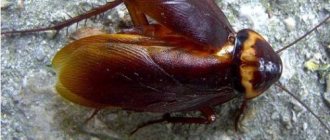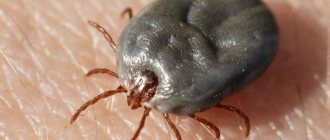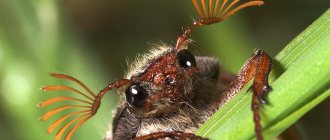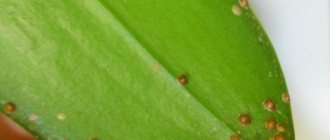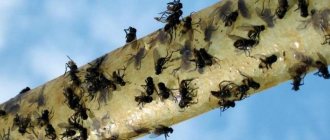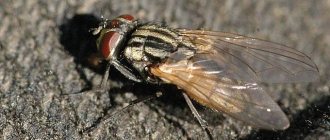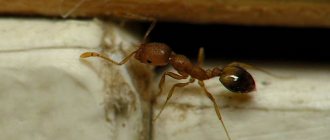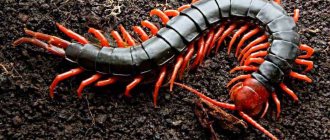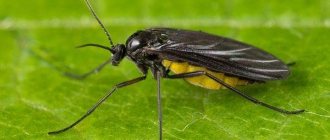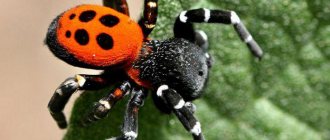White bugs on orchids - who are they?
The presence of white bugs on orchids requires eliminating the problem. Such bugs are most often small in size with an oblong shape and white or light color.
Such bugs suck the juices of their orchid flowers and leaves, which ultimately leads to the death of the plant. Bugs reproduce using eggs, and the larvae are resistant to external factors.
Depending on the type of bugs, which have a white coating, the citrus mealybug and the bristly mealybug are distinguished. These species belong to a related group, despite all the distinctive features.
Citrus mealybug
- A pest that attacks leaves, flowers and buds of orchids.
- They can form on a large number of flowers, including those growing outdoors.
- The bug has a body size of up to 5 mm, while the female has a crimson or pink color and a white coating.
- Males are smaller and can fly.
- Females can lay large numbers of eggs (up to 600), which allows pests to reproduce quickly.
- Such insects often appear on young shoots and infect healthy plants.
Bristle Mealybug
- The bugs have a body size of up to 4 mm and are orange in color, with a white coating on top.
- The bugs have a large number of legs and easily move around the plant.
- There are small formations on the body of the insect that resemble scales.
- On both sides of the bug's body there are small legs that turn into antennae.
- Females are viviparous insects; yellow spots appear on leaves that are affected by scale insects, which ultimately leads to the death of the flower.
Causes of parasites on an orchid
Mealybug on an orchid: how to get rid of pests and treatments
Mealybugs are not dangerous for a healthy plant. It attacks weakened specimens.
Affected plant
There are several reasons for the decrease in orchid immunity:
- insufficient lighting;
- poor watering;
- low humidity levels;
- abuse of fertilizers.
Such violations of the rules of care lead to changes in the composition of cell sap. A low level of nutrition (or excessive) prevents the plant from developing normally.
We must remember ! The optimal temperature for the life of a mealybug is about 25 °C. This means that heat-loving varieties of phalaenopsis are in greatest danger.
Signs of flower damage
Flower damage most often manifests itself with the following symptoms:
- the presence of yellow and dark spots on the leaves;
- leaf falling;
- destruction of buds;
- the presence of sticky drops on young shoots and leaves;
- marble shade on the leaves.
Let's celebrate! When examining the flowers, you can notice the presence of bugs and some kind of bags in which eggs are stored. Most often, such signs are most noticeable on the back of the leaves.
How to understand that orchids are affected by scale insects
If a whitish fluffy coating is noticeable on the surface of the leaves or peduncle, it means that the orchid has been attacked by a mealybug.
Also, the pest can be identified by a number of other signs:
- A white substance, in the form of a thick web, which is deposited by females,
- Sticky drops
- During the severely infested stage, leaves, stems and flowers become deformed and may rot.
Often, in addition to scale insects, you can notice signs of fungal or bacterial diseases, for example, rot.
Causes of the pest
White bugs very rarely appear without any reason, so certain conditions must be created for the bugs to appear.
The reasons for the formation of white bugs include:
- poor conditions for keeping the flower (dry air, excessively moist soil);
- wrong neighborhood;
- lack of proper plant care;
- proximity to recently purchased orchids that are carriers of infection.
Note! Poor-quality soil, which is used during plant transplantation, may also be the cause.
Danger to flowers
One of the most dangerous consequences for an orchid that can occur as a result of infection with white bugs is the use of orchid juice as food. As a result, the flower loses its vitality and gradually dies.
Another unpleasant sign left behind by mealybugs is sticky spots that cause fungus to appear and lead to infection of healthy leaves. Also, sticky spots can encourage the appearance of other harmful pests that negatively affect the condition and growth of the orchid.
Measures to combat scale insects on orchids
Mechanical methods
As soon as the presence of pests is suspected, the orchid is urgently isolated from other indoor plants before the bug moves to neighboring flowers.
- The first thing that can be done is to remove insects mechanically , using a cotton swab to clean them from leaves, stems, and buds. At the same time, it is important to remove not only insects but also the products of their vital activity - cobwebs. It makes it difficult for air to reach plant tissues.
- If there are too many pests, then it is better to remove the affected organs . Most of all, scale insects love young, juicy, immature sprouts. Therefore, they willingly settle on fresh shoots and new leaves. They contain the greatest amount of nutrients and fragile integumentary tissues, which the pest easily damages and sucks the juice from the plant.
- It is more difficult when scale insects accumulate in the leaf axils . You can only get them out of there with tweezers.
- Orchid species that have pseudobulbs are cleared of the pest by removing the integumentary scales.
- Severely affected and deformed ground organs are completely removed . They rob nutrients from healthy leaves and flowers.
- Sometimes it happens that mealybug affects not only ground organs, but also roots . In this case, an urgent transplant with pruning and resuscitation of the root system is required.
Traditional methods
At home, to control pests, it is better to use substances that will not cause damage to the plant and people. Here are some of them:
- To prevent the appearance of scale insects, orchid leaves are sprayed with an oily liquid. To prepare it you will need two tablespoons of any vegetable oil, poured with one liter of warm water. After spraying, a thin film is formed that is impenetrable to pests.
Advice. Note! Vegetable oil does not dissolve in water. To evenly apply the suspension to the surface of the leaves, the spray bottle must be shaken periodically while spraying.
Another remedy is:
- from liquid soap - 15 ml,
- denatured alcohol – 10 ml,
The components are dissolved in one liter of warm water.
The resulting liquid is used to wipe the leaves after the insects have been mechanically removed from the surface of the leaves.
Important! This product must be handled very carefully; the alcohol contained in the substance can cause burns to young leaves and varieties with thin integumentary tissues.
One of the simplest but most reliable ways is to wipe the leaves with soapy water . To prepare it, use ordinary gray-brown laundry soap.
- It is grated with a fine mesh grater,
- Dissolve in warm water until the lumps disappear completely.
- Then, thoroughly foam and wipe the affected organs of the orchid using a cotton swab.
Biological pest control
At home, it is better to use substances that will not harm either plants or people. Experts have developed a number of drugs based on biologically active microorganisms. They penetrate the plant tissue and stimulate the production of protective substances that repel insects. For the prevention and control of pests in confined spaces, the following bioinsecticides :
| The female individual is distinguished by a pink color and a whitish coating on the body. Insects will secrete a viscous liquid, which is what looks like a fluffy coating. Lifespan is on average 90-100 days. They can reproduce offspring already on the fifteenth day. The male is radically different from the female “half”, and looks like a light brown flying fly with transparent wings. Lives only four days. | |
| Bristle scale insect | Males are gray in color with transparent wings and look like flies. Females look like beetles, their bodies are reddish in color and their cover is whitish. Behind them stretches a “train” in the form of long hairs. Insects are able to secrete a special oily liquid. It protects them from negative influences, including from protective equipment |
| Fitoverm | The insectoacaricide is intended for spraying or for watering the substrate. |
Method for preparing the working solution:
Treatment should be carried out every 10-14 days.
Recommended dosage for spraying:
1 ml of the drug per 2 liters of water.
The disadvantage is high resistance, which means spraying is carried out only once. Then, the product needs to be changed.
Chemical insecticides
It is highly undesirable to use chemicals at home. They are resorted to as a last resort when all other methods of struggle have not brought the desired results.
It is best to carry out the treatment in an open space, such as a yard or garden. If this is not possible, then during spraying the plant should be taken out, at least to an open, well-ventilated balcony.
To control pests on orchids, insecticides designed to protect open ground plants are used. The following drugs are effective:
- Aktara,
- Vermitek,
- Aliot,,
- Spark,
- Bison,
- Kemifos,
- Fufanol,
- Doctor.
Review
Ekaterina Veniaminovna (Naberezhnye Chelny)
About a month after I was given the orchid, I noticed a white fluffy coating on it. It turned out that these were small insects with long white tails - mealybugs. I began to study the situation and came to the conclusion that, most likely, the pests came to me along with the gift. I had to isolate the orchid from other beauties and urgently treat it with Actofit. Apparently, I took the necessary measures in time, because I got rid of the worm quickly.
An orchid is an exotic flower that delights with its gorgeous blooms. However, the beauty of this plant is often hampered by insects and bugs that eat its leaves, roots and flowers. Find out where these parasites come from and what ways you can fight them.
How to get rid of white bugs?
In order to eliminate white bugs, you can use several methods, depending on the number of bugs on the orchid. Proper hygiene and plant care are of great importance.
Mechanical elimination
- To eliminate white bugs using a mechanical method, the infected petals or buds are completely removed.
- The infected plant is isolated in another place to prevent infection of healthy flowers.
- If bugs are found on the leaves, it is necessary to clean the area from bugs and eggs using a cotton pad.
- In cases where the bugs infect the core of the plant, the affected area is removed and the remains of the bugs are removed using tweezers.
Folk remedies
To eliminate pests, folk remedies are widely used, which prevent the further spread of bugs and do not cause harm to the flower.
The most commonly used methods are:
- Garlic. It is necessary to chop a clove of garlic and mix with water in equal proportions. The resulting solution should be used to wipe the leaves of the plant several times a day, depending on the number of bugs.
- The potato peels are washed with running water, after which they are added to boiling water in a ratio of 1:2 and boiled for at least 10 minutes, the resulting broth is cooled, and the plants are sprayed 2-3 times a day.
- For plants that have a large number of pests, soap solutions are used. To a liter of water you need to add 1 tablespoon of soap and a tablespoon of alcohol. Spray twice daily on leaves and buds.
Note! The use of traditional methods allows you to cope with the problem in the initial stages of development. If bugs appear in large numbers, it is recommended to use chemicals.
Chemicals
The use of chemicals requires strict adherence to the instructions, otherwise great harm to the orchid may be caused.
The following products are most often used for orchids:
- Mospilan.
- Neoron.
- Calypso.
- Aktofit.
- Vermitek.
Let's celebrate! The drug can be purchased at special flower shops; before starting use, it is recommended to try a small amount of the product on the lower leaves and leave for several hours.
Biological drugs
Biological preparations are based on beneficial microorganisms that eliminate bugs and increase the immunity of orchids before re-infection.
Biological drugs include:
- Phytofarm;
- Cesar;
- Aktofit.
These drugs are dissolved in warm water and sprayed throughout the plant.
Methods to combat bugs
There are drops on the leaves of an orchid - reasons
When the white bugs on the orchid have already colonized the entire bush, you need to take cleansing measures. To do this, the following actions are required:
- Replant the diseased plant.
- Collect all the bugs, wipe the leaves with a solution of laundry soap.
- Remove all oviposition and also treat with soapy water.
- Remove and destroy severely affected parts of the plant.
- Inspect all neighboring bushes (repeat every two days).
- Spray the entire surface under the pots with soapy water.
- Clean the window glass.
- Apply insecticides for severe infestation.
It is also necessary to get rid of flying males, for example, using sticky tape.
Traditional methods
If white furry bugs appear on an orchid, how to get rid of them using folk remedies?
Spraying a flower
For domestic plants, in particular orchids, the following methods have been widely used against scale insects:
- A solution of oil in water. For this, 2 tbsp. l. Any vegetable oil is stirred in a liter of water. The emulsion turns out to be quite liquid, so spraying can be done with a spray bottle.
- Garlic tincture. It is prepared at the rate of a head of garlic per half liter of water. The crushed slices are poured with boiling water and infused for about 5 hours. The solution is convenient to apply with a brush.
- Horsetail tincture. It needs to be made from 0.1 kg of dry grass and one liter of boiling water. The cooled liquid is ready for spraying the diseased flower.
- Soap-alcohol solution. To do this, 1 liter of warm water, 15 ml of liquid oil (10 g of soap shavings) are enough. After the soap is completely dissolved, add 10 ml of alcohol (20 ml of vodka). The product is applied with a brush .
Important ! Getting the product on the soil is undesirable.
For complete cure, it is recommended to treat phalaenopsis 3-4 times, with a break of 3 days.
Mechanical methods
Mechanical cleansing of an orchid from parasites is possible only with small lesions. Since it is almost impossible to get rid of white furry bugs on orchids if the bush is severely damaged. It consists of regularly removing live individuals and their eggs by hand.
Chemicals
When white fluffy bugs appear on an orchid, what should you do to combat them? The most effective chemicals in the fight against white bugs are insecticides.
Insecticides
Treatment should begin when young bugs emerge from the eggs. Considering the undulating nature of hatching of young animals, treatments should be repeated every two weeks for 2-2.5 months.
The principles of action of chemicals are different. There are two main ones:
- The first group is used for external use. The medicinal solution is applied to the ground area of the flower. He poisons the white beetle on the orchid. This occurs when eating a poisoned plant or coming into contact with poison.
- The second group is for application directly into the ground. The poison is transferred by the roots to the ground part of the flower and poisons the food of insects.
There are restrictions when using chemicals:
- After treatment, plants should be protected from direct sunlight.
- Strictly maintain the distance indicated in the instructions for use. By spraying at close range, you can freeze the above-ground part of the plant.
- Oil preparations must be applied strictly to the affected areas, as oil impedes the process of photosynthesis.
- Medicines in the form of sticks contain a significant proportion of fertilizer in the composition, so when using them, you need to reduce the amount of regular fertilizing. Excess fertilizer weakens the flower's immunity.
In any conditions, flowers can be attacked by pests. The simplest thing is to carry out preventive work, which consists of regular inspection. You should also follow the rules for caring for house plants. What to do if white bugs have already appeared on orchids? Start treatment immediately!
Prevention of plant damage
To prevent infection of an orchid, it is necessary to follow prevention methods, which include:
- maintaining a temperature of no more than 23 degrees;
- the air must be moist;
- regularly inspect plants for possible infections and pests, and if found, separate them from the rest;
- promptly clean the leaves from dust and possible contaminants.
Good to know! Orchids are delicate plants that do not like overly moist soil, so you need to water the flowers as needed with warm water.
Prevention measures
You may encounter a mealybug invasion if you do not adhere to the optimal conditions for keeping the orchid:
For orchids, it is necessary to constantly carry out preventive measures.
You can get a full-scale epidemic if you do not pay attention to the first signs of infection :
- Sticky drops;
- White plaque;
- Yellowing of leaves.
To prevent infection it is necessary :
- Observe optimal conditions for growing orchids;
- Keep the plant clean , that is, regularly, at least once every 2 months, wipe the leaves and tubers with damp swabs. You can moisten them in a solution of succinic acid, 1 tablet per 1 liter of water, you will get double benefits;
- Each time you water, carefully inspect the flower for the presence of white coating and sugar drops;
- In spring and autumn, carry out preventive treatment with insecticides or acaricides. You can spray with a solution of Neem oil or use folk recipes;
- When purchasing a new tropical beauty, take precautions :
- Carefully examine the orchid;
- If there is a white coating, drops of syrup or yellowing of the leaves, refuse to purchase;
- Remove all dry scales remaining from dead leaves;
- Place the purchased plant in quarantine for 2-3 weeks, having previously treated the flower against pests.
Some tips for optimal content :
- Provide good lighting in accordance with the type of orchid;
- Optimal temperature for keeping the plant;
- Regular ventilation of the room, but without drafts;
- Timely watering and spraying;
- Do not overdo it with nitrogen fertilizers;
- Ambient air humidity;
- Preventive inspection and treatment.
Other orchid pests
In addition to mealybugs, a large number of other pests can form on orchids, which cause no less harm to the flower.
These include:
- Red mites are small bugs that suck sap from plants and weave webs between leaves.
- Thrips are small black bugs that have an oblong body. Most often they are located on the plant in pairs, have wings and can move from plant to plant.
- Scale is an insect that has a transparent color and is most often located on the leaves of orchids.
- White midges are pests that are about two mm in size, white in color and have two wings. They can move from an infected plant to a healthy one and lay eggs on the inside of the leaf.
- Aphids - insects that are most often green in color have long legs and are most often located in groups on the leaves.
Note! To eliminate bugs, you need to know what kind of insect it is, and then purchase special preparations to protect the orchid.
Description
Having looked carefully, the velvety spots turn out to be insects of an oval shape and color :
These bugs look like spilled flour.
It looks like they are sprinkled with flour . This insect is called a "mealybug". You can see a photo of white fluffy bugs with a tail above.
There are more than 1,800 species of this pest worldwide. We have 5 types of mealybug :
- Bristly;
- Grape;
- Citrus;
- Root;
- The Comstock scale is found in Central Asia and the Caucasus.
The mealybug belongs to the family of hemiptera or arthropodous bugs.
The male and female are completely different from each other.
The male is a small flying moth or fly without a mouth opening.
But what we see on the orchid is a female, it can have dimensions from 2 to 5 mm. The velvety covering is a yarn of wax that she surrounds herself with to protect herself from the sun and drying out.
To reproduce, a mealybug does not necessarily need to have a pair, that is, the development of the egg into an adult organism occurs without fertilization .
Ways to fight
In order to prevent the mealybug from spreading to all pets, it is necessary not only to water the plant , but to carefully inspect it each time for the presence/absence of pests.
If this did happen, then:
- The orchid must be urgently isolated, making sure to check the nearby plants;
- Use cotton swabs to remove visible scale insects by wetting the sticks with vodka, calendula tincture or water;
- Give the orchid a hot shower at 40 - 50 degrees, which is destructive for mealybugs;
Traditional methods
When you don’t have chemicals at hand or don’t want to use them, you can prepare folk remedies :
- Garlic tincture . Crush or grate 5 cloves of garlic, pour in 0.5 liters of boiling water, leave for 4 hours, filter, brush the leaves and tubers with an undiluted solution;
- Vodka with soap . For 1 liter of water 15 g. liquid soap and 10 ml of alcohol or 20 ml of vodka. Apply to places where insects accumulate. It is necessary to first try on a small area of the orchid, since there are plants that are very sensitive to alcohol;
- Oil solution. 1 liter of warm water, 2 tablespoons of olive oil, mix thoroughly and spray the flower;
Folk remedies help fight mealybugs at home. - Horsetail decoction . 100 gr. horsetail, pour 1 liter of boiling water, cool to 40 - 50 degrees, spray the orchid.
After these procedures, it is necessary to thoroughly blot the leaf axils and the growing point.
Mechanical cleaning
Without mechanical cleaning, getting rid of mealybugs will be very problematic. What does it consist of :
- Using a damp swab or cotton swab, clean the orchid from visible pests;
- If the peduncle or buds of the plant are affected, it must be cut off and discarded;
- Old leaves leave dry scales on the stems/pseudobulbs - they need to be removed , as there may be clutches of eggs or mealybugs themselves. Remove the latter with a damp swab;
- Mealybugs love settle on young leaves or orchid sprouts, which contain a large number of amino acids. It is quite difficult to remove the pest from there. You can try to do this with a toothpick or soak an orchid removed from the substrate in a soap solution - the scale insects will come out on their own;
You can remove mealybugs yourself at home. - If the plant is sympodial, remove the covering leaves from the young pseudobulb; they still do not live long.
Important! The orchid must be transplanted into fresh soil, treating the roots with an insecticide or one of the folk remedies. In case of extensive damage, treat the plant with a fungicide.
To prevent re-infestation, the window sill and glass are washed with detergents , and the curtains are washed. The plant can be treated with fungicides.
Chemicals
Chemicals are available in two types :
- Granules or sticks . This is not suitable for orchids due to the composition of the soil in which they grow and the fertilizer content in the preparations themselves;
- Liquids or emulsions . Oil emulsions are applied to areas where insects sit. But you need to know : since oil clogs the stomata of plants, this leads to the death of flowers in large areas affected by the pest.
In turn, liquid preparations are divided into:
- Contact - affecting pests upon contact with the insect itself, effective only on young individuals. These include Fozalon;
- Gastric - the insect enters the stomach through the mouth opening. Aktelik, Aktara, Vertimek;
- Systemic - when this remedy is used, the plant absorbs it into itself, becoming poisonous to parasites. Phosfamide, Rogor.
Substances acting on mealybug:
- Malathion;
- Diazinon;
- Dimethoad;
- Parathion.
To be sure to get rid of mealybugs, it is necessary to carry out 4-5 treatments every 7-10 days with preparations with different active ingredients. During the treatment period, you should not keep the flower in bright sunlight.
Description of the insect and the damage caused
Mealybug is an insect with an oval, waxy body up to 6 mm long, usually colored white, light beige or pinkish. People call these insects “hairy lice” or “felt lice.” The insect has transverse grooves on its back, and small bristles are located along the perimeter of the body. These insects, which are relatives of scale insects, inhabit not only plants, but also the substrate in pots.
Male scale insects are equipped with wings, but they do not have a mouthparts: adult individuals do not require food, since they die after mating. Females do not have wings, but they have a long proboscis with which they pierce the ground organs of the plant to suck out the juice. Before laying eggs, the female produces a cotton-like substance that covers plant leaves with a white coating. It is by this coating that the presence of scale insects is guessed.
In one season, scale insects produce 3-4 generations, and the light gray fluffy larvae also begin to suck the juice from the orchid.
Most often, scale insects hide in the depths of leaf axils and crawl into buds and flowers. As a result of their vital activity, the leaves become covered with a white marble pattern, the orchid flowers are deformed, the plant weakens and becomes easy prey for various infections, and the digestive enzymes of the pests slow down the metabolic processes in the plant. The sweetish secretion of scale insects, which is more often called honeydew, is a favorable environment for the sooty fungus, which covers the ground organs of the orchid with a black coating.
Other pests of Phalaenopsis orchids and their treatment
In addition to the pests already mentioned, the following can settle on orchids:
- Scale insects are dangerous pests that are not easy to get rid of. Adult insects under their shell are practically invulnerable to pesticides. Therefore, when scale insects are detected, adult insects must be removed and destroyed. The plant is then treated with insecticides to kill the larvae. The treatment is repeated several times with an interval of 7-10 days;
- Aphids are a common pest of orchids. These insects are very prolific and quickly form large colonies. They feed on plant sap, causing leaves to curl and die. They are also dangerous because they carry various viral and fungal infections, which kill the plant even faster than the pest itself. Spraying with insecticidal preparations helps well against aphids;
Shchitovka
Aphid
Thrips
Spider mite
- Spider mites are sucking insects that feed on plant sap. It often attacks orchids. It is difficult to notice due to its small size, but the cobweb coating on the back of the leaves is very visible. First of all, the mite infects young leaves and growing points, which can cause the orchid to die. It is destroyed only with special preparations to combat harmful arachnids. Of the listed funds, this is Actellik. The plant is treated with it at least 3 times with an interval of 7-10 days;
- Thrips are harmful flying insects that attack not only the ground part of the plant, but also its roots. If they are detected, the plant must be isolated from the rest and treated with an insecticide until complete destruction at intervals of no more than 10 days. It is also recommended to treat the substrate in the pot, as thrips can hide in it and damage the root system.
Picture of the disease
At first glance, this pest looks like a small piece of cotton wool, but under the white bristles, which are threads of wax, hides an oval-shaped insect about 0.4-0.5 centimeters in size. This is a female mealybug.
The insect feeds on the juices of the plant and, as a result, deprives it of useful substances necessary for normal development. An additional problem is created by a sweet secretion (honeydew), which is intensively secreted by females. This sticky liquid, remaining on the leaves and stem of the orchid, can cause the development of fungus or attract other pests. A particularly large volume of honeydew is produced by female citrus mealybugs, which are most often found on orchids.
Symptoms of an orchid being affected by a mealybug:
- small white furry bugs are localized on the leaves, peduncles, buds, and core of the orchid;
- sticky spots or drops on the surface of the leaves;
- white powder-like coating;
- yellowing (or redness) and falling of leaves;
- slowing or stopping growth;
- deformation of buds and flowers.
Attention!
An unpleasant feature of most species of these pests is the ability of females to reproduce without fertilization by males. Moreover, each individual can lay 200-400 eggs.
See also: “Caring for an orchid in a pot at home.”
Folk remedies
Folk remedies will help fight mealybugs. They are available and safe, but are ineffective against large-scale flower damage. It is justified to use home remedies in the initial stages of infection or for preventive purposes.
The most popular folk methods of struggle are as follows:
- soak a cotton pad in alcohol tincture of calendula and wipe the affected areas. Repeat the treatment until the parasites are completely removed;
- combine 3 tbsp. l. olive oil and 1 liter of water. Use the resulting solution to spray the orchid while fighting mealybugs and other parasites;
- mix 1 liter of water, 1 tbsp. l. liquid soap and 15 ml of ethyl alcohol. Use the resulting solution to wipe the affected leaves and stems of the plant, avoiding contact with the soil;
- dilute horsetail tincture in water (in equal proportions) and spray the orchid until the flower is completely cured;
- Fill a heat-resistant container with potato peelings, add water, bring to a boil and boil for 10 minutes. Strain the cooled broth and use it to spray indoor flowers;
- boil 1 liter of water, add a head of chopped garlic to the boiling water, boil for 2 minutes, and then let it brew for 5 hours. Strain the resulting infusion and use it to treat leaves and stems.
Folk remedies can be used to spray plants infected with the pest, as well as healthy flowers for preventive purposes.
